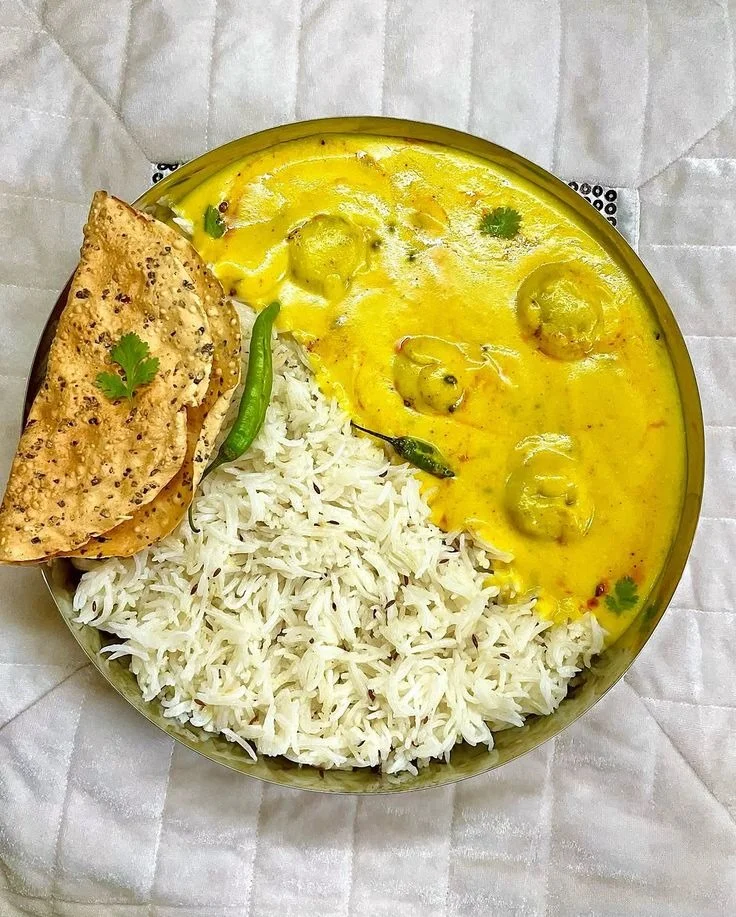
There are those days when all that you longing for something simple. No fancy step, no special ingredients. Something that makes you feel rooted, something that nourishes your body as well as your soul. That’s precisely what Moong Dal Khichdi, made in the true ISKCON style, tastes like.
It’s not merely another rice and lentil recipe—it’s a sacred offering, a bowl of peace, purity, and warmth imbued with centuries of devotion, Ayurvedic insight, and spiritual intent.
I’ve prepared this khichdi more times than I care to remember—on gloomy days when I needed solace, on festival mornings before going to the temple, and countless times just because my heart craved something soul-nourishing. I’ve also realized over the years that what makes this khichdi “ISKCON-style” is not about ingredients or cooking procedures. It’s about your attitude towards it—with love, concentration, and awareness. It’s about cooking for Krishna, not merely for yourself.
So here we are today, going through the recipe—not in the technical sense but as one friend to another. A little chat in the kitchen with the spices crackling and the dal bubbling.
Let’s Start with the Basics: What Is ISKCON Khichdi?
ISKCON temples all over the globe use a very disciplined sattvic method of cooking. That is, the food is cooked without onion, garlic, and tamasic foods. They prepare it with purity of heart, cleanliness, and first offer it to Lord Krishna before anyone else consumes it.
Moong dal khichdi is:
Easy on the stomach
Full of natural flavors
Prepared with simple pantry ingredients
Packed with spiritual energy
It’s usually served as part of prasadam in temples, with halwa, chutney, and sometimes sabzi or kheer. But truthfully, even on its own, it’s complete.
Ingredients: What You’ll Need
Get all the things ready before you cook. Not just your body, but your mind as well. Quiet your mind a bit, perhaps put on soft music in the background, and start.
Grains and Lentils
1 cup yellow moong dal (split and husked)
¾ cup basmati tukda rice (It is mandatory)- Or make it according to people
Vegetables (Optional but gorgeous additions)
1 small potato, peeled and chopped
1 small carrot, chopped
5–6 green beans, chopped
½ cup green peas (fresh or frozen)
For Tempering
2 tablespoons pure desi ghee
1 teaspoon cumin seeds
1 inch grated ginger
1 pinch asafoetida (hing) – use a satvik or rock-based version
½ teaspoon turmeric powder( according to your taste )
1 or 2 green chilies (optional and slit, not chopped)
Seasoning
Salt,( according to your taste )
Garnish
Fresh coriander leaves, chopped (optional)
A tsp ghee on top when serving
Preparation: The Gentle Art of Cooking with Devotion
Step 1: Wash and Soak
Start by washing the moong dal and rice 3–4 times under running water. You’ll notice the water becoming cloudy at first—this is normal. Rinse until the water runs somewhat clear. Soak them together for about 15–20 minutes. Soaking helps them cook faster and digest better.
While it’s soaking, chop your vegetables and prep your spices.
Step 2: Dry Roasting the Dal (Optional but Worth It)
Here’s one little trick I picked up from a temple cook in Vrindavan: lightly roast the moong dal before cooking. Not to brown it too much, but just until it releases that nutty smell. It totally transforms the depth of flavor.
So in a heavy-bottomed pan, dry roast the soaked and drained moong dal over low flame for 3–4 minutes. Stir constantly so it doesn’t get burnt.
Now return the rice to it and lightly mix it.
Step 3: The Sacred Tempering
I love this bit. There’s something so satisfactory about spices coming into contact with warm ghee.
In a pressure cooker or heavy-bottomed pan:
Heat the ghee slowly—don’t overheat.
Add cumin seeds. Let them crackle and diffuse their scent.
Add grated ginger. The aroma will hit you at once.
Add green chilies if using.
Now a pinch of hing, and turmeric.
Throw in your chopped veggies and sauté them for just one minute. Don’t fully cook them, they will get cooked along with the dal and rice.
This tempering—if done patiently—lays the ground for the flavors. In ISKCON, even this step is performed without consciously tasting or smelling anything because the food is offered to Krishna first.
Step 4: Bringing It All Together
Add the soaked (and if desired, roasted) moong dal and rice mixture to the cooker or pot. Gently stir everything so the ghee covers every grain.
Add water—4 to 4½ cups depending on whether you want it soft or softer. I like mine semi-mushy, temple-style prasadam. If you prefer it dry and fluffy, cut the water a little.
Add salt.
Step 5: Cooking It Right
If cooking with a pressure cooker, close the lid and simmer for 2–3 whistles on a medium flame. Allow the pressure to reduce naturally.
If using a pot, cover and simmer on low heat for 25–30 minutes. Stir now once in a while so nothing sticks at the bottom. Add more water if necessary.
You will see the aroma shift as it cooks. It will smell warm, earthy, and comforting—like a warm hug.
Once prepared, fluff it softly with a spoon. Don’t mush it unless you prefer it that way.
Step 6: Presenting It to Lord Krishna (Optional but Gorgeous)
If you want to prepare this as prasadam, do not taste or smell while cooking.
Use a small, sanitized plate. Place a serving of the khichdi on it. Garnish with tulsi leaves on top (if available), and put it on an available altar space or sanitized corner of your kitchen.
Close your eyes. Recite the Hare Krishna Maha-Mantra once or three times:
Hare Krishna Hare Krishna Krishna Krishna Hare Hare
Hare Ram Hare Ram Ram Ram Hare Hare
You can also recite a quick offering prayer in your own words. Then, after some minutes, stir this offering plate into the main pot. This way, the whole khichdi becomes prasadam.
Serving Suggestions: How to Make It a Full Meal
ISKCON-style khichdi is a meal in itself, yet to make it a complete experience, here are some sattvic sides that complement it nicely:
Fresh curd or plain cucumber raita with rock salt
Tomato or mango chutney prepared in the absence of onion or garlic
Sweet halwa (suji or atta) as a celebratory touch
Papad – roasted, not fried, for chaste reasons
A cup of warm jeera water or herbal tea after meals
And don’t forget that little extra dash of ghee on the top of the khichdi before serving. It’s not only delicious—it’s Ayurvedic gold for digestion.
Why I Return to This Khichdi
You know, we run around in our contemporary times, pursuing a lot—tastes, fads, fusion cuisine. But meals like these cause you to remember to return home.
Each time I cook this khichdi, it brings me down a notch. It makes me remember that food is not only sustenance—it’s an offering. A ritual. A relationship.
I’ve served this khichdi to sick friends, to the elderly who needed comforting, and even to visitors on Navratri or Ekadashi. No one has ever complained. Everybody goes in for seconds.
And there’s something incredible about the way you feel after eating it—light, contented, and peaceful.
Final Thoughts:-
If you’ve never tried temple-style khichdi before, give this a shot. Not just as a recipe, but as a little pause in your day. A chance to stir something simple with a whole lot of intention.
Turn off distractions. Play a soft bhajan. Let the cumin sizzle, the ghee melt, and your worries drift.
Because at the end of the day, food such as this isn’t so much for eating. It’s for being felt.
Hare Krishna!🙏
—




This brought back such warm memories! ISKCON-style khichdi has such a unique taste—simple yet so full of flavor and peace. I’ve been exploring more satvik recipes lately alongside some learning, and recently joined a digital marketing course in Delhi to grow my skills. Also found Culture of Internet super helpful for digital learning. Thanks for sharing this soul-soothing recipe—it’s more than just food, it’s a feeling!